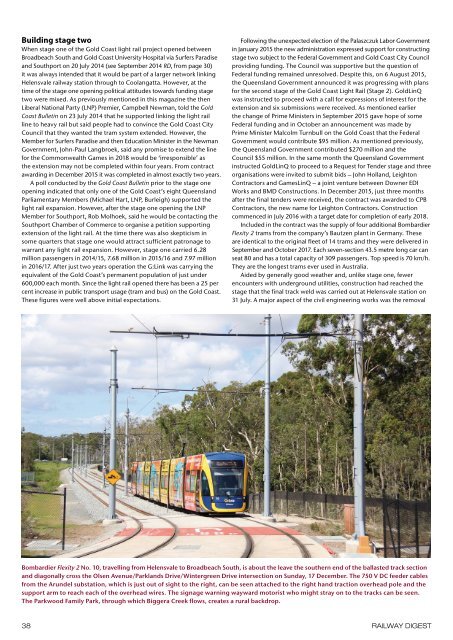Railway_Digest__February_2018
You also want an ePaper? Increase the reach of your titles
YUMPU automatically turns print PDFs into web optimized ePapers that Google loves.
Building stage two<br />
When stage one of the Gold Coast light rail project opened between<br />
Broadbeach South and Gold Coast University Hospital via Surfers Paradise<br />
and Southport on 20 July 2014 (see September 2014 RD, from page 30)<br />
it was always intended that it would be part of a larger network linking<br />
Helensvale railway station through to Coolangatta. However, at the<br />
time of the stage one opening political attitudes towards funding stage<br />
two were mixed. As previously mentioned in this magazine the then<br />
Liberal National Party (LNP) Premier, Campbell Newman, told the Gold<br />
Coast Bulletin on 23 July 2014 that he supported linking the light rail<br />
line to heavy rail but said people had to convince the Gold Coast City<br />
Council that they wanted the tram system extended. However, the<br />
Member for Surfers Paradise and then Education Minister in the Newman<br />
Government, John-Paul Langbroek, said any promise to extend the line<br />
for the Commonwealth Games in <strong>2018</strong> would be ‘irresponsible’ as<br />
the extension may not be completed within four years. From contract<br />
awarding in December 2015 it was completed in almost exactly two years.<br />
A poll conducted by the Gold Coast Bulletin prior to the stage one<br />
opening indicated that only one of the Gold Coast’s eight Queensland<br />
Parliamentary Members (Michael Hart, LNP, Burleigh) supported the<br />
light rail expansion. However, after the stage one opening the LNP<br />
Member for Southport, Rob Molhoek, said he would be contacting the<br />
Southport Chamber of Commerce to organise a petition supporting<br />
extension of the light rail. At the time there was also skepticism in<br />
some quarters that stage one would attract sufficient patronage to<br />
warrant any light rail expansion. However, stage one carried 6.28<br />
million passengers in 2014/15, 7.68 million in 2015/16 and 7.97 million<br />
in 2016/17. After just two years operation the G:Link was carrying the<br />
equivalent of the Gold Coast’s permanent population of just under<br />
600,000 each month. Since the light rail opened there has been a 25 per<br />
cent increase in public transport usage (tram and bus) on the Gold Coast.<br />
These figures were well above initial expectations.<br />
Following the unexpected election of the Palaszczuk Labor Government<br />
in January 2015 the new administration expressed support for constructing<br />
stage two subject to the Federal Government and Gold Coast City Council<br />
providing funding. The Council was supportive but the question of<br />
Federal funding remained unresolved. Despite this, on 6 August 2015,<br />
the Queensland Government announced it was progressing with plans<br />
for the second stage of the Gold Coast Light Rail (Stage 2). GoldLinQ<br />
was instructed to proceed with a call for expressions of interest for the<br />
extension and six submissions were received. As mentioned earlier<br />
the change of Prime Ministers in September 2015 gave hope of some<br />
Federal funding and in October an announcement was made by<br />
Prime Minister Malcolm Turnbull on the Gold Coast that the Federal<br />
Government would contribute $95 million. As mentioned previously,<br />
the Queensland Government contributed $270 million and the<br />
Council $55 million. In the same month the Queensland Government<br />
instructed GoldLinQ to proceed to a Request for Tender stage and three<br />
organisations were invited to submit bids – John Holland, Leighton<br />
Contractors and GamesLinQ – a joint venture between Downer EDI<br />
Works and BMD Constructions. In December 2015, just three months<br />
after the final tenders were received, the contract was awarded to CPB<br />
Contractors, the new name for Leighton Contractors. Construction<br />
commenced in July 2016 with a target date for completion of early <strong>2018</strong>.<br />
Included in the contract was the supply of four additional Bombardier<br />
Flexity 2 trams from the company’s Bautzen plant in Germany. These<br />
are identical to the original fleet of 14 trams and they were delivered in<br />
September and October 2017. Each seven-section 43.5 metre long car can<br />
seat 80 and has a total capacity of 309 passengers. Top speed is 70 km/h.<br />
They are the longest trams ever used in Australia.<br />
Aided by generally good weather and, unlike stage one, fewer<br />
encounters with underground utilities, construction had reached the<br />
stage that the final track weld was carried out at Helensvale station on<br />
31 July. A major aspect of the civil engineering works was the removal<br />
Bombardier Flexity 2 No. 10, travelling from Helensvale to Broadbeach South, is about the leave the southern end of the ballasted track section<br />
and diagonally cross the Olsen Avenue/Parklands Drive/Wintergreen Drive intersection on Sunday, 17 December. The 750 V DC feeder cables<br />
from the Arundel substation, which is just out of sight to the right, can be seen attached to the right hand traction overhead pole and the<br />
support arm to reach each of the overhead wires. The signage warning wayward motorist who might stray on to the tracks can be seen.<br />
The Parkwood Family Park, through which Biggera Creek flows, creates a rural backdrop.<br />
38 RAILWAY DIGEST



